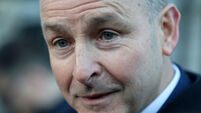Ring of intrigue
ON June 3, 2008, key directors of the Irish National Stud gathered at their headquarters in Tully, Co Kildare, to reflect on the most successful year in its history.
They pored over the origins of a profit which was enormous for a company of its size. The text of Lady Chryss O’Reilly’s report, explaining how the extraordinary year came to pass, was accepted. Her board also signed off on the technical language used to fulfil its obligations and inform the public about the multi-million euro profit three people at the table had reaped as part of the Invincible Spirit stallion syndicate.
















